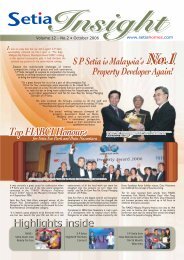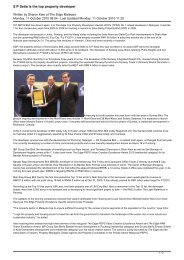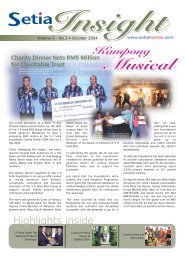Change - S P Setia Berhad
Change - S P Setia Berhad
Change - S P Setia Berhad
You also want an ePaper? Increase the reach of your titles
YUMPU automatically turns print PDFs into web optimized ePapers that Google loves.
86<br />
Annual report 2008<br />
NOTES TO THE FINANCIAL STATEMENTS<br />
FOR THE YEAR ENDED 31 OCTOBER 2008<br />
1. SIGNIFICANT ACCOUNTING POLICIES (cont’d))<br />
(g)<br />
Associated companies<br />
An associated company is an entity in which the Group has significant influence and that is neither a subsidiary company nor<br />
an interest in a joint venture. Significant influence is the power to participate in the financial and operating policy decisions<br />
of the investee, but is not control or joint control over those policies. The existence and effect of potential voting rights that<br />
are currently exercisable or convertible are considered when assessing whether the Group has significant influence.<br />
In the Company’s separate financial statements, investments in associated companies are stated at cost less impairment<br />
losses. Impairment losses are charged to income statement.<br />
On disposal, the difference between the net disposal proceeds and the carrying amount of the associated company disposed<br />
of is taken to the income statement.<br />
Investments in associated companies are accounted for in the consolidated financial statements by the equity method of<br />
accounting. Under the equity method, the investments in associated companies are initially recognised at cost and adjusted<br />
thereafter for post-acquisition changes in the Group’s share of net assets of the associated companies.<br />
The Group’s share of net profits or losses and changes recognised directly in the equity of the associated companies are<br />
recognised in the consolidated income statement and consolidated statement of changes in equity, respectively.<br />
An investment in an associated company is accounted for using the equity method from the date on which the Group<br />
obtains significant influence until the date the Group ceases to have a significant influence over the associated company.<br />
Premium relating to an associated company is included in the carrying value of the investment and it is not tested for<br />
impairment separately. Instead, the entire carrying amount of the investment is tested for impairment in accordance with the<br />
accounting policy set out in (v)(ii) below.<br />
Discount on acquisition is excluded from the carrying amount of the investment and is instead included as income in<br />
the determination of the Group’s share of the associated company’s profit or loss in the period in which the investment<br />
is acquired.<br />
Unrealised gains on transactions between the Group and its associated companies are eliminated to the extent of the<br />
Group’s interest in the associated companies. Unrealised losses are also eliminated unless the transaction provides evidence<br />
of impairment of the asset transferred.<br />
Equity accounting is discontinued when the carrying amount of the investment in an associated company diminishes by<br />
virtue of losses to zero, unless the Group has incurred legal or constructive obligations or made payments on behalf of the<br />
associated company.<br />
The results and reserves of associated companies are accounted for in the consolidated financial statements based on<br />
audited and/or unaudited management financial statements made up to the end of the financial year and prepared using<br />
accounting policies that conform to those used by the Group for like transactions in similar circumstances.

















